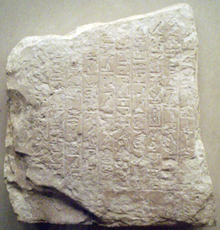
Back Koptosdekrete German Coptos Decrees English Decretos de Coptos Spanish Décrets de Coptos French Maklumat Coptos ID Koptoški odloki Slovenian

Els Decrets de Coptos són 18 reials decrets complets o en fragments de l'Antic Egipte que van des de la Dinastia VI (2345–2180 abans de la nostra era) fins a la Dinastia VIII (c. 2170 ae).
Els primers van ser emesos per Pepi I i Pepi II per a afavorir el clergat del Temple de Min, mentre que altres se n'han datat del regnat de faraons de les dinasties VII i VIII, i tracten d'alguns favors concedits a un important oficial de Coptos anomenat Shemay i a la seua família.[1][2] Els decrets reflecteixen la decadència del poder dels faraons a la primeria del Primer període intermedi d'Egipte.
Els decrets de Coptos no s'han de confondre amb el Decret de Coptos de Nubjeperra Intef, un document únic datat de la Dinastia XVII d'Egipte.
- ↑ Alan Gardiner, Egypt of the Pharaohs: an introduction, Oxford University Press, 1964, p. 108; quote: "But perhaps the most persuasive evidence of their short-lived domination is offered by some inscriptions discovered by Raymond Weill at Coptos in 1910-11. Under the ruins of a structure of Roman date were found carefully stowed away a number of decrees carved in hieroglyphic on slabs of limestone, some dating from the reign of Pepy II, and most of them designed to protect the temple of Min and its priesthood from interference and the corvee. But among them as many as eight were apparently dispatched on the same day in the first year of a King Neferkare, the last king but one in the series of the Abydos list. The addressee was in each case the vizier Shemai and each royal command was concerned either with him or some member of his family. One of the decrees confirmed him in his vizierate in all the twenty-two nomes of Upper Egypt, while another recorded the appointment of his son Idi to the post of Governor of Upper Egypt in the seven southernmost nomes. A third decree grants precedence over all other women to Shemai's wife Nebye, who is described as a 'King's eldest daughter', and perhaps even more remarkable is a fourth making elaborate arrangements for the funerary cult of both husband and wife in all the temples of the land. There is no hint of unrest or political disturbance in any of these texts, though we may possibly read into them a desperate anxiety on the king's part to conciliate one specially powerful Upper Egyptian magnate."
- ↑ Toby Wilkinson, The Rise and Fall of Ancient Egypt: The History of a Civilisation from 3000BC to Cleopatra, London, Bloomsbury, 2010, ISBN 978-0-7475-9949-4, pp. 121–22.